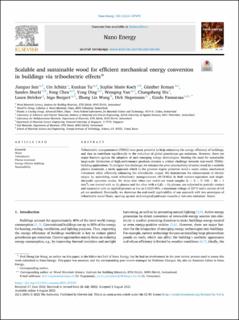Please use this identifier to cite or link to this item:
https://doi.org/10.21256/zhaw-25453Full metadata record
| DC Field | Value | Language |
|---|---|---|
| dc.contributor.author | Sun, Jianguo | - |
| dc.contributor.author | Schütz, Urs | - |
| dc.contributor.author | Tu, Kunkun | - |
| dc.contributor.author | Koch, Sophie Marie | - |
| dc.contributor.author | Günther, Roman | - |
| dc.contributor.author | Stucki, Sandro | - |
| dc.contributor.author | Chen, Feng | - |
| dc.contributor.author | Ding, Yong | - |
| dc.contributor.author | Yan, Wenqing | - |
| dc.contributor.author | Wu, Changsheng | - |
| dc.contributor.author | Stricker, Laura | - |
| dc.contributor.author | Burgert, Ingo | - |
| dc.contributor.author | Wang, Zhong Lin | - |
| dc.contributor.author | Hegemann, Dirk | - |
| dc.contributor.author | Panzarasa, Guido | - |
| dc.date.accessioned | 2022-08-19T07:21:44Z | - |
| dc.date.available | 2022-08-19T07:21:44Z | - |
| dc.date.issued | 2022 | - |
| dc.identifier.issn | 2211-2855 | de_CH |
| dc.identifier.issn | 2211-3282 | de_CH |
| dc.identifier.uri | https://digitalcollection.zhaw.ch/handle/11475/25453 | - |
| dc.description.abstract | Triboelectric nanogenerators (TENG) have great potential to help enhancing the energy efficiency of buildings, and thus to contribute significantly to the reduction of global greenhouse gas emissions. However, there are major barriers against the adoption of such emerging energy technologies. Meeting the need for sustainable large-scale fabrication of high-performance products remains a critical challenge towards real-world TENGs’ building applications. To mitigate this challenge, we enhance the poor polarizability of native wood by a scalable plasma treatment, a facile approach which to the greatest degree preserves wood's warm colors, mechanical robustness while efficiently enhancing the triboelectric output. We demonstrate the enhancement of electric output by assembling wood triboelectric nanogenerators (W-TENGs) in both contact-separation and single-electrode operation modes. We show that when two radial-cut wood samples (L × R × T: 100 × 80 × 1 mm3), one treated with an O2 plasma and the other with a C4F8 + O2 plasma, are subjected to periodic contact and separation with an applied pressure as low as 0.0225 MPa, a maximum voltage of 227 V and a current of 4.8 µA are produced. Eventually, we showcase the real-world applicability of our approach with two prototypes of triboelectric wood floors, opening up new technological pathways towards a ‘net-zero emissions’ future. | de_CH |
| dc.language.iso | en | de_CH |
| dc.publisher | Elsevier | de_CH |
| dc.relation.ispartof | Nano Energy | de_CH |
| dc.rights | http://creativecommons.org/licenses/by/4.0/ | de_CH |
| dc.subject | Wood | de_CH |
| dc.subject | Sustainability | de_CH |
| dc.subject | Triboelectric | de_CH |
| dc.subject | Plasma treatment | de_CH |
| dc.subject | Energy-efficient building | de_CH |
| dc.subject.ddc | 621.04: Energietechnik | de_CH |
| dc.title | Scalable and sustainable wood for efficient mechanical energy conversion in buildings via triboelectric effects | de_CH |
| dc.type | Beitrag in wissenschaftlicher Zeitschrift | de_CH |
| dcterms.type | Text | de_CH |
| zhaw.departement | School of Engineering | de_CH |
| zhaw.organisationalunit | Institute of Materials and Process Engineering (IMPE) | de_CH |
| dc.identifier.doi | 10.1016/j.nanoen.2022.107670 | de_CH |
| dc.identifier.doi | 10.21256/zhaw-25453 | - |
| zhaw.funding.eu | No | de_CH |
| zhaw.issue | 107670 | de_CH |
| zhaw.originated.zhaw | Yes | de_CH |
| zhaw.publication.status | publishedVersion | de_CH |
| zhaw.volume | 102 | de_CH |
| zhaw.publication.review | Peer review (Publikation) | de_CH |
| zhaw.funding.snf | 184821 | de_CH |
| zhaw.webfeed | Klebstoffe und Polymere Materialien | de_CH |
| zhaw.author.additional | No | de_CH |
| zhaw.display.portrait | Yes | de_CH |
| Appears in collections: | Publikationen School of Engineering | |
Files in This Item:
| File | Description | Size | Format | |
|---|---|---|---|---|
| 2022_Sun-etal_Wood-efficient-mechanical-energy-conversion_NanoEnergy.pdf | 12.13 MB | Adobe PDF |  View/Open |
Show simple item record
Sun, J., Schütz, U., Tu, K., Koch, S. M., Günther, R., Stucki, S., Chen, F., Ding, Y., Yan, W., Wu, C., Stricker, L., Burgert, I., Wang, Z. L., Hegemann, D., & Panzarasa, G. (2022). Scalable and sustainable wood for efficient mechanical energy conversion in buildings via triboelectric effects. Nano Energy, 102(107670). https://doi.org/10.1016/j.nanoen.2022.107670
Sun, J. et al. (2022) ‘Scalable and sustainable wood for efficient mechanical energy conversion in buildings via triboelectric effects’, Nano Energy, 102(107670). Available at: https://doi.org/10.1016/j.nanoen.2022.107670.
J. Sun et al., “Scalable and sustainable wood for efficient mechanical energy conversion in buildings via triboelectric effects,” Nano Energy, vol. 102, no. 107670, 2022, doi: 10.1016/j.nanoen.2022.107670.
SUN, Jianguo, Urs SCHÜTZ, Kunkun TU, Sophie Marie KOCH, Roman GÜNTHER, Sandro STUCKI, Feng CHEN, Yong DING, Wenqing YAN, Changsheng WU, Laura STRICKER, Ingo BURGERT, Zhong Lin WANG, Dirk HEGEMANN und Guido PANZARASA, 2022. Scalable and sustainable wood for efficient mechanical energy conversion in buildings via triboelectric effects. Nano Energy. 2022. Bd. 102, Nr. 107670. DOI 10.1016/j.nanoen.2022.107670
Sun, Jianguo, Urs Schütz, Kunkun Tu, Sophie Marie Koch, Roman Günther, Sandro Stucki, Feng Chen, et al. 2022. “Scalable and Sustainable Wood for Efficient Mechanical Energy Conversion in Buildings via Triboelectric Effects.” Nano Energy 102 (107670). https://doi.org/10.1016/j.nanoen.2022.107670.
Sun, Jianguo, et al. “Scalable and Sustainable Wood for Efficient Mechanical Energy Conversion in Buildings via Triboelectric Effects.” Nano Energy, vol. 102, no. 107670, 2022, https://doi.org/10.1016/j.nanoen.2022.107670.
Items in DSpace are protected by copyright, with all rights reserved, unless otherwise indicated.